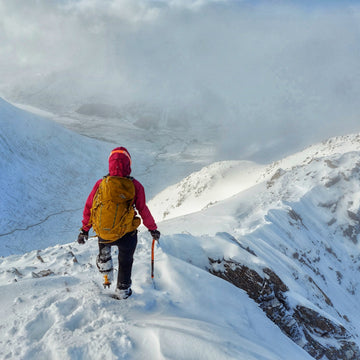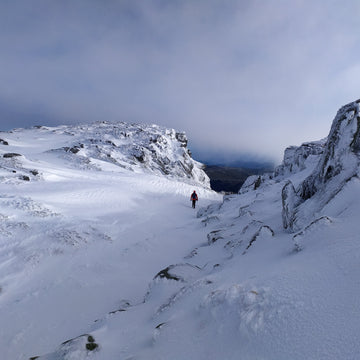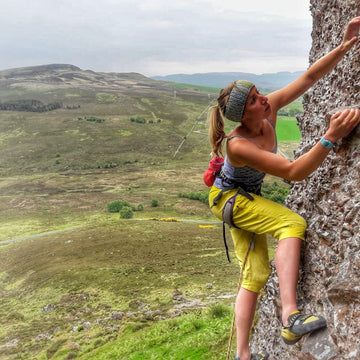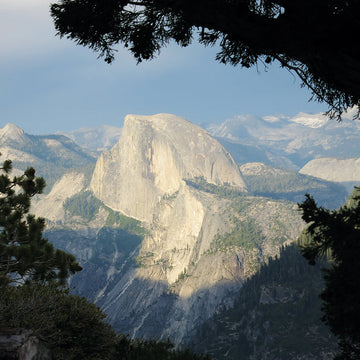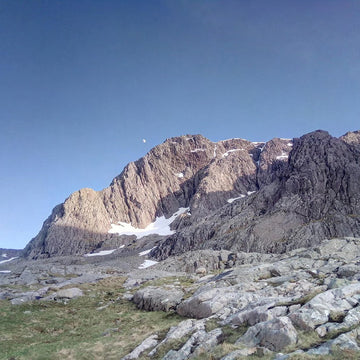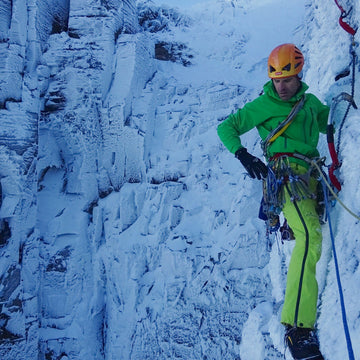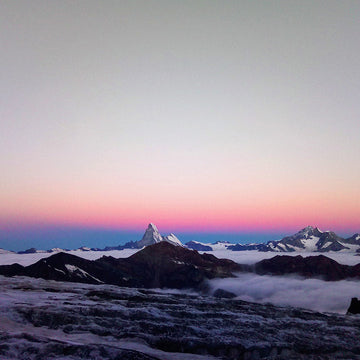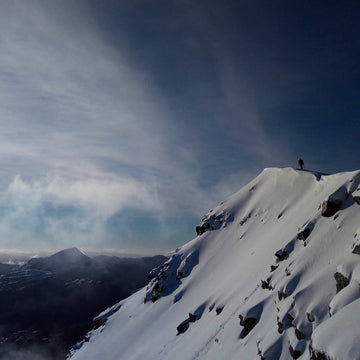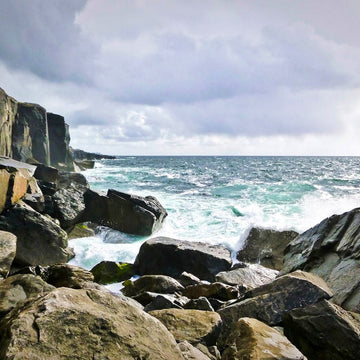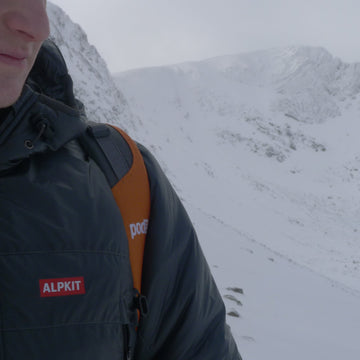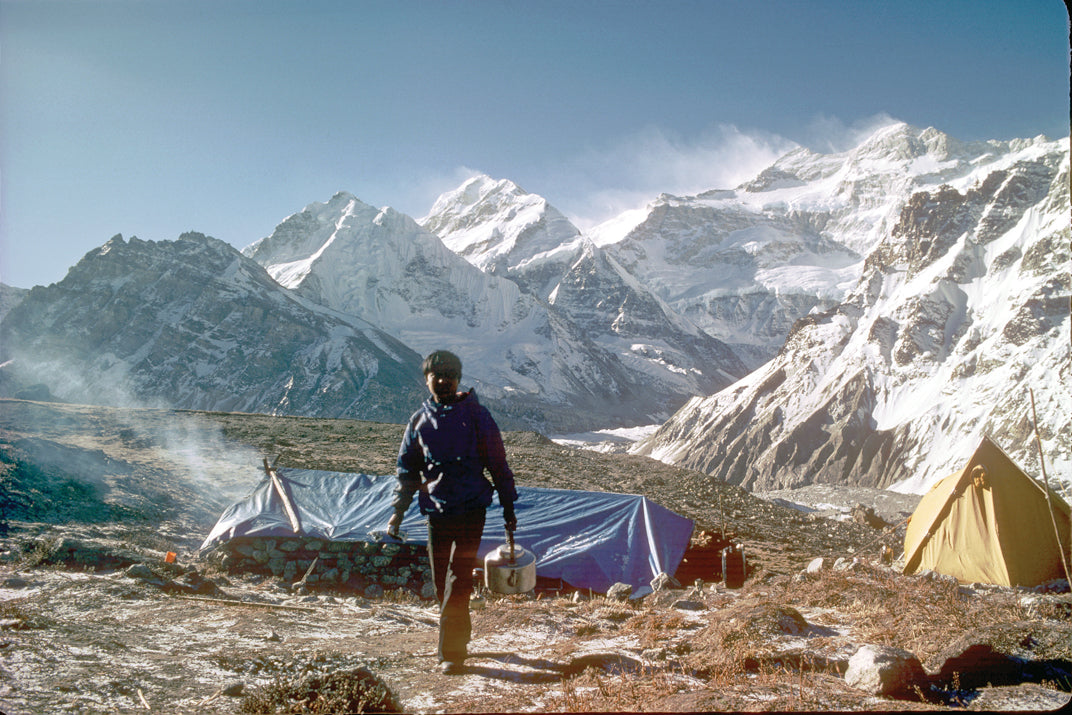
The First Ascent without Supplementary Oxygen
What you are about to read is an exclusive extract from the book "Kangchenjunga" by Doug Scott, which can be purchased here from the Vertebrate Publishing website. To see more books we love and books that caught our eye, check out our bookshelf.
The first attempt
Georges and I led off, carrying about eleven kilos each, with our ski poles for higher up. We reached our high point by 2 p.m. Pete and Joe were not in sight, so Georges and I loaded up with an enormous weight of camera gear, stove, pans, two days’ food, down suits, over-suits, shovels, spare clothes, spare glasses, goggles, candles, head torches – it was all I could do to stand up, never mind pull myself up the ropes at 6,700m. Georges took off, leading out for forty metres. I led for another fifteen metres to easier slopes. Georges then led through a chimney of rotten rock.
Unfortunately, he knocked off some rocks while leading and I knocked off more while hauling my gear behind me. As Georges headed off, Joe appeared from below to shout through the now stormy weather that Nima had psyched out lower down and Ang Phurba had gone back with him; also that Pete had been hit on the hand by one of the falling rocks: he thought it might be broken. I could see him start to make a painful descent with Ang Phurba and Nima.
Everything that had started so well that morning was now falling apart. Still, Joe and I plodded on after Georges to just below the col. The most spectacular views of Everest and Makalu appeared through a slot in the seething golden clouds above the valleys, the big mountains black against mauve and purple skies.

Eventually, we collapsed into a little tunnel tent which Georges had brought from Seattle. We were absolutely done in after this monumental effort. It was very cramped, especially for Joe, who lay at the entrance, over the slope. Georges groaned all night, with the wind howling outside, but the tent stood up well considering it weighed only two kilos. I slept fitfully, trying to keep myself from rolling on to others.
At 7 a.m. I left the tent to relieve myself. The only windless spot I could find was over the col in Sikkim. And that was how we made it to the North Col of Kangchenjunga. There was complete calm on the other side, with brilliant early morning views eastwards into the rising sun coming up behind Siniolchu.
We migrated there straightaway, digging out a platform and half a snow cave to accommodate one of our two tents. We moved into the tents as the snow fell and, looking down the Twins glacier, wondered how far up John and Joy Hunt had reached when exploring a way to the North Col just before the war.
Joe was now suffering excruciating headaches, for which he was taking large doses of the strong analgesic fortral. He had arranged that Ang Phurba would bring up a load that day and let us know about Pete’s damaged hand. The advantage of a small group like ours was that everyone knew what to do without awaiting direction, like Joe when he oversaw Nima and Pete’s descent.
From Castaneda, I noted:
A warrior cannot complain or regret anything, his life is an endless challenge and challenges cannot possibly be good or bad … Without the awareness of death, everything is ordinary, trivial …
I could not disagree, for up here it made enormous sense. But I knew that down below it was a different matter.
That afternoon, thunder was in the air – something I had never really noticed before when high up. We could all imagine the massive falls of snow to follow. My tent was looking more spartan now, as bit by bit I had shed my burden, leaving behind everything inessential. Once, a book to read and a book to write in might be considered superfluous. I read a bit more from the teachings of Don Juan and noted:
The best of us always comes out … when we feel the sword dangling overhead. Personally, I wouldn’t have it any other way.
And neither would I, now that at last we seemed to be en route and committed, despite our problems: Joe was flat out with a steamy headache and there was still no word of Pete from Ang Phurba.
They arrived the next day; Pete was able to climb. Sadly for Joe, another day and night of pain and nausea spelt descent for him.
On 1 May, it was agreed that Pete, Georges and I would continue to the ridge to check it out and leave some food as high as possible, then descend to sleep at the col. Joe’s problems made us very aware that we had to monitor our own acclimatisation very carefully. Georges was in his element, moving fast for two and a half hours, winding his way up snow and ice between pinnacles of rock until we stopped for a lunch of kippers and tea, then continued for another hour to the foot of a tower of crumbly rock. There seemed to be a good opportunity here to make a snow cave in a bank of wind-blown snow. To the left, the slope led up 100m to the big rock band below the great scree terrace.
It took us only an hour to descend to the col – we were pleased about that, but sad to see Joe, a tiny dot below, walking along the track into Camp 2. We lay around under heavy snowfall, discussing what to do next. Georges was all for going for it, Pete for a cautious build-up and protecting our retreat. None of us knew how fit we would be up there. But we were eager to try for the summit and there was no talk of waiting for Joe.
I had a wonderful seven-hour sleep and woke, fully refreshed, to begin the morning rituals. We stuffed our sleeping bags and some spare clothing into our sacks, added a tent, left a note for Joe and Ang Phurba, and set off up the ridge in a harsh, cold wind. Georges and I followed Pete, unroped. This cheered him up: he was obviously on the mend. When we reached our little cache we began to dig a cave and took stock of our situation. There were no signs of people around Camp 2. It looked as if Joe had gone all the way down to Base Camp. There was not a cloud anywhere and the view was clear to all horizons: being on a ridge was far more enjoyable than the claustrophobic south-west face of Everest.
We eventually dug through both sides of the snowbank and, after meeting in the middle, began to hollow out the interior. At 7,470m, it was hard work and took us three and a half hours. But we did a good job and ended up with a huge, safe haven against storms. We had no energy left to check out the rock steps above, so spent the afternoon melting snow for brews and filling our water bottles for the morning, full of optimism that we could make our bid for the top next day – then be on our way to Kathmandu and home to our families.
That night I did not sleep well. I had earache and took two aspirins, the first pills I had taken on a mountain since 1972. I seemed to be getting another cold and blamed myself for getting so wet by digging the cave without my over-suit on. Throughout the night, Georges fidgeted in his half-sleep, got up to look for a mug to pee in – at which Pete and I protested! Despite all this, we got away by 7 a.m. I led up soft, deep snow for about 150m to the rock step. We left the last of the Czech rope hanging below us to secure our retreat.
The climbing was quite difficult, up granular snow with no place for solid anchors but, as we were in a shallow couloir, we were sheltered by the rocks on our right. I pulled up and over to the great scree terrace and met the full force of the westerly winds. I could hardly stand: time to go down to our ice palace for kippers and brews. We discussed what to take with us the next day and felt guilty about Joe. If we did not leave soon, we would have to go down for more food.
By 10 a.m. we had reached the screes of the great terrace. Pete was going well but Georges was very tired: I seemed to be towing him across the terrace, five paces then a pull on the rope, usually mid-step, a real drag. The wind was vicious, strong enough to blow flaky bits of rock uphill. During the worst gust, we had to huddle together until a slight lull allowed us to jump up, stumbling and tripping over the boulders until the next blast had us cowering, backs to the wind, clutching our down and windproof suits. At least we were cocooned against the cold. I tried to rationalise the wind’s impact by reasoning: ‘It’s only air particles, only wind moving around the globe – get with it, lad, you’re not freezing yet.’

Then we would resume, staggering on another few paces.
The nearer we got to the ridge, the stronger and noisier the wind became. On the crest, we became the first obstruction the westerlies had met since Everest. I felt an electric charge in my back, like a hundred needles jabbing into my spine, addling my marrow. The only way out lay down, through the static of hundreds of flying particles, to the relative calm of Sikkim.
About twenty metres down we started the laborious, three-hour job of hacking a tent platform out of the steepening slope that dropped 2,000m to the Zemu glacier. Enough room, but not enough oxygen at 7,900m with the door shut and the fumes from the stove. I struggled to melt ice for tea and, somewhat more grudgingly, for a hot-water bottle for Georges’ cold feet. I took a headache pill and slept well, until Pete woke me at 1.30 a.m. to help with our wind-hammered tent: the central fibreglass hoop had broken. By 2.30 a.m., the wind was extreme, as was our position. We panicked our way into over-suits, boots and gaiters, working in shifts as Pete and I took turns to hold the broken ends of the hoop to prevent it tearing the fabric. Our gloved hands were wet and cold. Then, every climber’s nightmare: the whole tent was blown a metre along the ledge, towards the drop. I tore the zip open and bounded outside, heels dug into the ledge, gripping the tent, trying to prevent it, Pete and Georges from plunging down to the glacier.
This was the wildest wind I had ever known: chips of ice flew in my face and blasted my nylon suit. I grabbed an ice axe and rammed it through the tent fabric where the ties had ripped off. I stamped it down, but the wind simply ripped the tent away another few centimetres, leaving me holding on with both hands, as poles snapped and bits of fabric tore off. Georges yelled for his crampons; I flung them in, yelling to pack everything in our rucksacks: ‘Don’t abandon anything!’ I was determined that this was not going to be a rout. The outer sheet of the tent stripped off and flew, pale orange, into the cold night. And all the time I clung on, wrestling with the surviving hoop, finally twisting it down and breaking it to lower the tent’s resistance. I felt I was losing, with my frozen hands and failing strength, scared I was going to lose the gear, my friends and myself, all tumbling down to the Zemu …
‘Surely, this isn’t the way I’m going down – blown off a bloody mountain, sliding into an unknown valley – come on, get a grip.’
I shouted for them to get out quick. First a Karrimat came through the entrance, followed by rucksacks then Pete. Georges was last, cutting his way out of the back with his Swiss penknife, still drowsy from too many sleepers. As he emerged, we let go of the tent and it flew off, another black shape fast disappearing. It became a dot in the distance, then was gone.
It was now 4.30 a.m. We squatted on that icy ledge, two metres long and just over a metre wide, in the strongest wind any of us had ever experienced. Summit thoughts were non-existent; indeed, we still had to get ourselves down.
For the first hour we clung to each other, moving through a stupor of cold and utter misery. Pete was not saying anything; he seemed to be getting hypothermia. I thought that this time I had gone a step too far. For the second time in my life, I thought I was going to die.
Our situation was deteriorating fast. Georges realised this first and, in a burst of energy, dashed off up the ropes we had tied off to a deadman belay plate three metres above us. From this, he made a bold attempt to reach the col twelve metres away, but the rope was wind-tangled and pulled him up short. He attempted twice more before reversing to our ledge. My turn. As I stood up, I felt so unstable that I dipped back down, my head bunched into my chest, hiding from the flying ice and snow. I wrenched my sack off, grabbed two ice axes and pulled up to the deadman plate. Then, with frozen fingers, bit by bit, I untangled the flailing rope. Georges joined me and paid out the rope as I reached a point just below the col. I came to a dead halt, blasted by the winds, crouching on crampon points and ice picks, my face pressed against the ice, trying to find some relief from the turbulence.
Georges shouted, ‘Doug, go for eet, go for eet!’ but I missed a slight lull when I could have risked moving. ‘Go for eet, Doug!’ yelled Georges again. I went for it, scampering up on blunt crampons, scraping and scratching at the hard green ice in a continuous flailing of limbs, trying to reach the top before the next onslaught. I threw myself over the ridge and squirmed above Nepal on my stomach, literally clawing my way down the slope with ice picks to some rocks, where I tied off.
Without goggles and glasses, my face was covered in ice, with a coating of frozen snot and sputum on my beard and hair, but I was now out of immediate danger. I thought about getting my hair cut at a certain barber’s in Kathmandu – the first alien thought after hours of total concentration on survival.

Eventually, Georges squirmed over the ledge.
‘Doug, my sack, eet has down the Zemu glacier!’
‘Don’t worry, kid, we’ll get it all together!’ I yelled, as we both pulled Pete over to join us. We began to stagger and shuffle down to the cave bivouac at 7,620m, and arrived there at 10 a.m. We had climbed down to the col by 1 p.m. then continued down the north face to Base Camp two hours later. Joe could not stop talking. After all the worry of waiting, he fussed around us, plying us with brews and food. We had descended 3,000m, and covered eight kilometres of the mountain all in a day, but then we had got off to an early start!
This first attempt at Kangchenjunga had been my closest call. I will never forget it, because I was oblivious to all else but surviving the wind and the cold when, at George’s insistence, I ‘went for eet’, to face the unknown with adrenaline running high, exhilarated, detached, free and climbing beyond ego, going for it.
During the next few days, I lay on the grass under my flysheet, dreamlike, watching animated scenes of home behind my eyelids. I wondered if I had learnt anything. I just felt so much at peace, so relaxed with myself and my friends. I would always feel warmth towards them from having shared that ordeal, and to Joe, who had contained his disappointment at not being with us, but who then took care of us.
I sat on the grass at Base Camp, my bottom bony and my body skinny, nursing my frostbitten finger-ends, stinging from strong antibiotic cream, wrapped up in Joe’s white silk gloves. Although I now had excuses to leave, there was Kangchenjunga, still smoking snow and mist. What a mountain it was turning out to be! I now knew many of its secret places, at least to 8,000m on the north-western flank, but I did not know about that last 600m.
We took rest days on 7 and 8 May. By 9 May, all of us had returned to Camp 2. Reaching it only took some three and a half hours from Base Camp, showing that we must have recovered.
During the next two days we planned to climb to camps 3 and 4, then take off from the snow cave for the summit, climbing all night if all went well with the weather, to get ourselves down during daylight hours before suffering too much from the altitude. There was not a breath of wind and, from appearances, none at the top either: just our luck! My frostbitten fingers were mending, but blisters had appeared on my right hand’s small and ring fingers, like burns or scalds. Pete had a frost blister on his big toe, and a numb nose and ear. Georges had recovered from his snow-blindness and Joe was raring to go.





